Recent closures of all city park facilities include Dog Off-Leash Areas. Understandably, this leaves many Torontonians struggling to find ways to ensure that their companions are getting the amount of exercise and engagement they need for a healthy and joyful life. Unfortunately, it also seems to be leading to a notable surge in off-leash dogs romping around our parks & natural areas.
While the many negative impacts of off-leash dogs are very well-known, Toronto’s COVID-19 response adds some new influences that should be considered if you’re tempted to let your dog roam without restraint:
- Off-leash dogs make physical distancing more difficult. Trying to break-up an encounter between dogs, especially one that has turned overly-playful or even aggressive, is virtually impossible while respecting a 2 metre distance.
- Over recent weeks, rescues & shelters have been encouraging new fostering arrangements intended to connect people and pups while we all observe social & physical distancing measures. These new companions are just starting to get to know one another, and may not be able to predict each other’s behaviors, expectations, etc. This could provoke unforeseen, unpleasant, or even dangerous interactions with your off-leash dog.
- Off-leash dogs stress some people out. For scores of potential reasons, off-leash dogs make many people nervous, sometimes terrified, even on the best of days. These are not the best of days. Imposing additional stress on your fellow citizens is simply unkind.
- Off-leash dogs can threaten wildlife reproduction & plant propagation. Thanks to the significant decline in human-use of our parks & natural areas, folks are starting to report evidence of breeding, nesting, sprouting etc. in areas much closer to trails than is typical. Let’s give them a chance to thrive.
“But what are we supposed to do now?”
It’s a totally valid question with no easy answers. We reached out to some dog-loving TFN members to find out what they’ve been doing to keep their furry friends active and stimulated during this unusual time, without introducing risks to wildlife or damage to our natural areas. In case it’s of help to you, or someone you know, here are a few suggestions they’ve offered:
- Teach an old dog a new trick! This is a great time to focus on training – something new, or even just re-enforcing things like sit, stay and come.
- Take longer walks. You might not be able to provide them with the same intensity of exercise, but you can compensate for that with distance and duration.
- Increase indoor play. Tug-of-war could be a great game for some (but not all!) dogs. Others might enjoy “hide and treat” with a old blanket. Use your imagination and your dog’s fav toys to make new games in limited space.
- Add some obstacles. If you have a backyard, consider using an old storage bin, hula hoop, sprinkler, and other things from around the house to create an obstacle course.
- Just engage! Spend extra time each day doing routine things like grooming, chatting, or just being affectionate.
Our members also wanted to share a few links they found when searching for inspiration and ideas:

